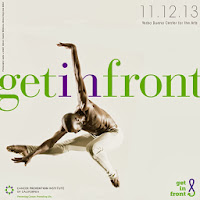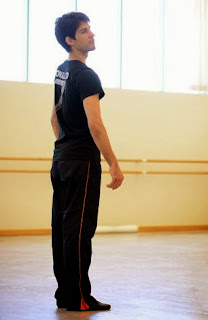 |
| Photos by Erik Tomasson/SFBallet |
San Francisco Ballet’s “Nutcracker”
War Memorial Opera House
It was five minutes to curtain and to say things were not going well was an understatement.
“I don’t want to see it. I want Daddy!”
“Sweetie, we just sat down.”
“I don’t want to see it, I want to go home.”
“But what about the Sugar Plum Fairy?”
“I DON’T WANT TO! WANNA GO HOME!”
Up until this moment I had imagined that I was “Mom-ing” pretty darn well. My three and a half year old daughter loved watching ballet rehearsals, and had just the week before sat through a Nutcracker suite for a good hour. We watched the “Nutcracker” DVD straight through (with only a fast forward past the big battle scene) and she had been captivated, immediately demanding to watch it again all the way through.
“Well, now,” I thought, “ if she can watch the ballet twice through, she’s surely focused enough to see the real thing.” I like to imagine that I’m not a ballet mom. But as someone who grew up adoring the yearly tradition of seeing the Balanchine “Nutcracker” with my Dad every year, I was perhaps a little over-anxious to get that tradition going with my own daughter.
So on Thursday night, we got dressed up, and headed to the opera house quite early to sit and have dinner together in the cafe downstairs. She was delighted with the decorations and keenly observing other folks in their “party clothes.” We went upstairs for an obligatory photo in front of the Christmas tree and then headed into the theater. She had a program clutched in one hand and I even remembered to snag a booster cushion for the chair. I felt like a pro.
The wailing began almost as soon as we were seated. This was nothing I hadn’t seen before, but, as they say, it’s different when it’s your kid doing the banshee cry. I’m not sure what triggered it. I want to blame the kids sitting behind us talking about the battle with the King of the Mice. In any case, suddenly she was sobbing and adamant that she wanted to leave. At 6:54 p.m.
I won’t bore you with the details of the negotiation, but we came to a hasty agreement that we could stand in the very back in standing room (so as to be able to make an escape more easily.) I couldn’t say this aloud, but I had a firm conviction in my mind that she would have only to hear the strains of Tchaikovsky’s score and I could win her over. The Nutcracker could win her over. Ballet could win her over. And as it turned out, I was right.
She hid her face in the lapel of my coat as we stood at the back of the house. But as the ever-beguiling Pascal Molat fussed with his Nutcracker, she couldn’t resist peeking, before ducking back under the coat.
“Do you want to see?”
“I don’t want to see!” came the violent sotto voce response.
But as the music built up and the tree lights flickered on, her head emerged again.
“There are kids!”
“Indeed,” I replied in a neutral tone.
And the flock of youngsters onstage, comporting themselves so charmingly, brought her another inch from under the coat.
“What a lovely dancing doll,” I murmured.
“Her dress is pink,” she mused thoughtfully. “Like the Sugar Plum Fairy.”
Jahna Franziskonis and Alexander Reneff-Olson’s sweet solos intrigued her enough that she was still watching when Wei Wang emerged magically from his box as the Nutcracker doll.
“It’s him,” she whispered dramatically.
“Indeed,” I replied in a neutral tone putting a finger to my lips.
As the music took a wistful tone and the guests began to leave, I asked her if she wanted to step outside so she wouldn’t see the battle. There were limits after all.
The affirmative nod came quick and we went out to the grand lobby, where we examined the tree and the Nutcracker dolls. I could hear the strains of the music--Christmas tree building, gargantuan furniture rolling in, soldiers deployed, and mice arrayed against them. The sounds of battle, and then the unmistakable denouement. I’m sorry, Sean Bennett, for having missed what I’m sure was the glorious demise of your Mouse King.
“Do you want to go back inside? We can see the dance of the snowflakes now,” I suggested.
In my mind the chances of her agreeing were 50-50, so I was a little surprised when she said yes, and started leading me back to the door. We bellied up to the standing room rail again, this time joined by a father who was holding his daughter of about the same age. He and I exchanged rueful glances and I turned my attention to the stage in time to catch Molat lifting the mask off the Nutcracker to reveal the handsome Tiit Helimets.
I’ve seen the “Nutcracker” so many times, and I’ve seen Helimets in the role more times than I can count on one hand. But seeing it through my daughter’s eyes, I have never so appreciated the chivalrous care and princely attention that he lavished on his Clara (Chloe Treanor). His Nutcracker Prince partnered her with the same expressive detail and graciousness that he offered her older counterpart, Sofiane Sylve, in the grand pas de deux. Suddenly I could feel myself falling in love with the ballet again after many years of a sort of jaded love-hate relationship with it.
 |
| Photos by Erik Tomasson/SFBallet |
“They’re dancing in the snow!”
“Indeed,” I replied in a neutral tone.
The curtain came down and we headed into intermission, twirling nonstop through the lobby. She didn’t say much, preferring to promenade me in grander and grander circles. But under it all, I wondered, would we be able to sit through the second act?
At last firmly positioned in our seats, I largely ignored the patrons in front of and behind us, who observed us with guarded expressions. The lights went down and I wrapped an arm around her shoulders, enjoying the sudden look of concentration on her face.
As Sasha De Sola bourreed elegantly into the midst of assorted butterflies, dragonflies and ladybugs, I murmured, “Look, it’s the Sugar Plum Fairy.”
My daughter turned to me with one finger to her lips and said, “Shhhh.”
“Indeed,” I replied in a neutral tone and settled back in the seat.
Tickets to the Nutcracker are available on www.sfballet.org.

























